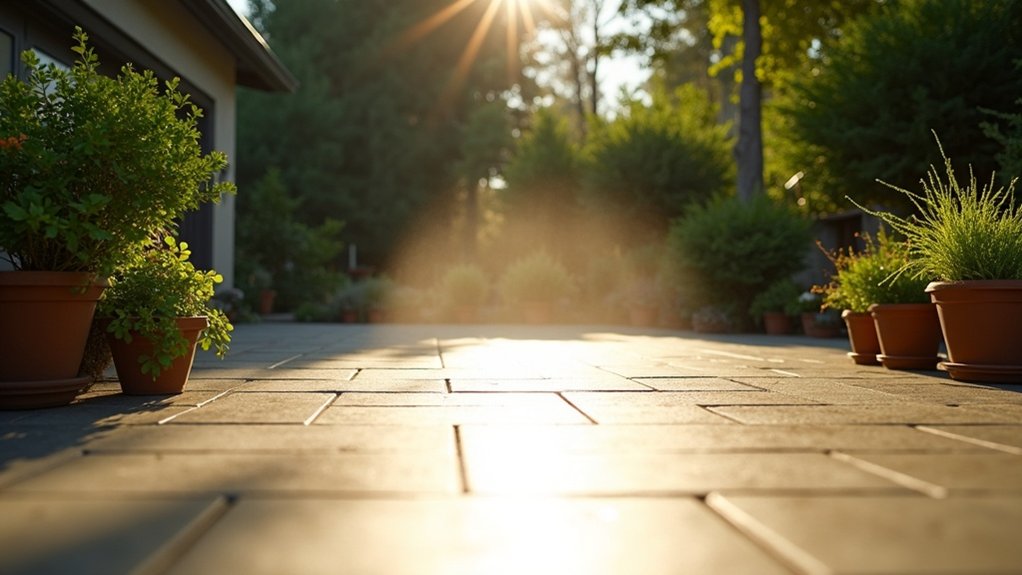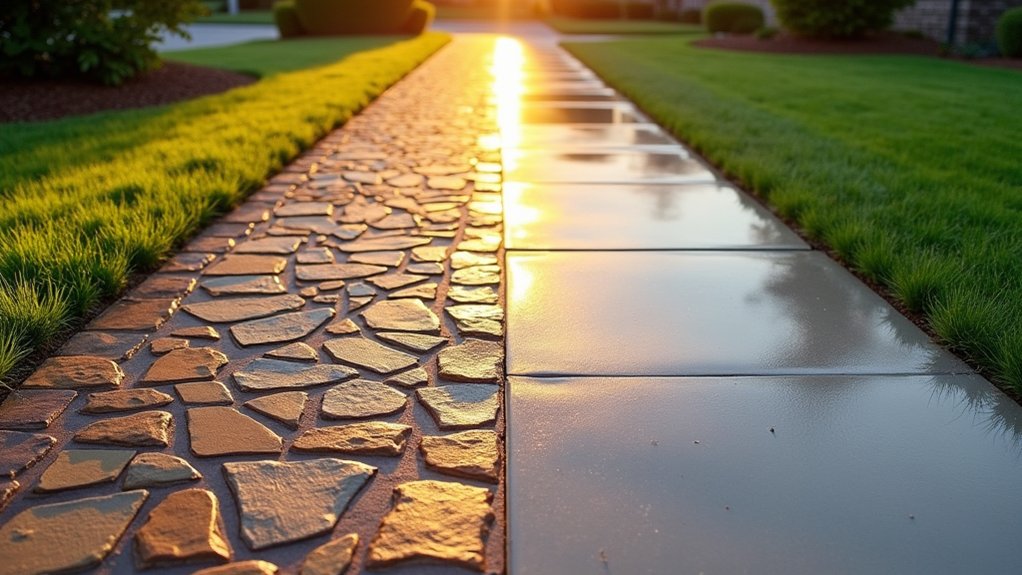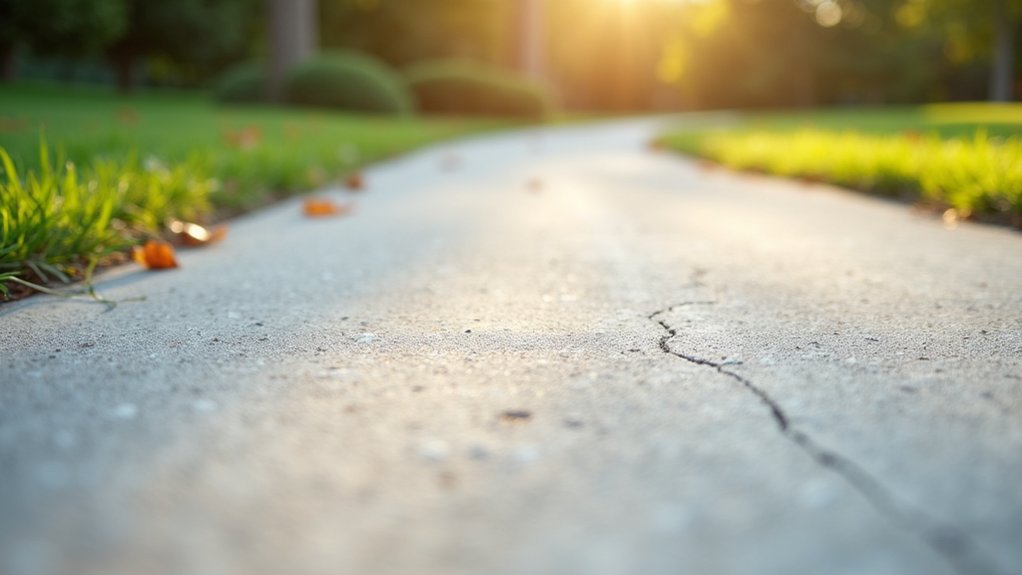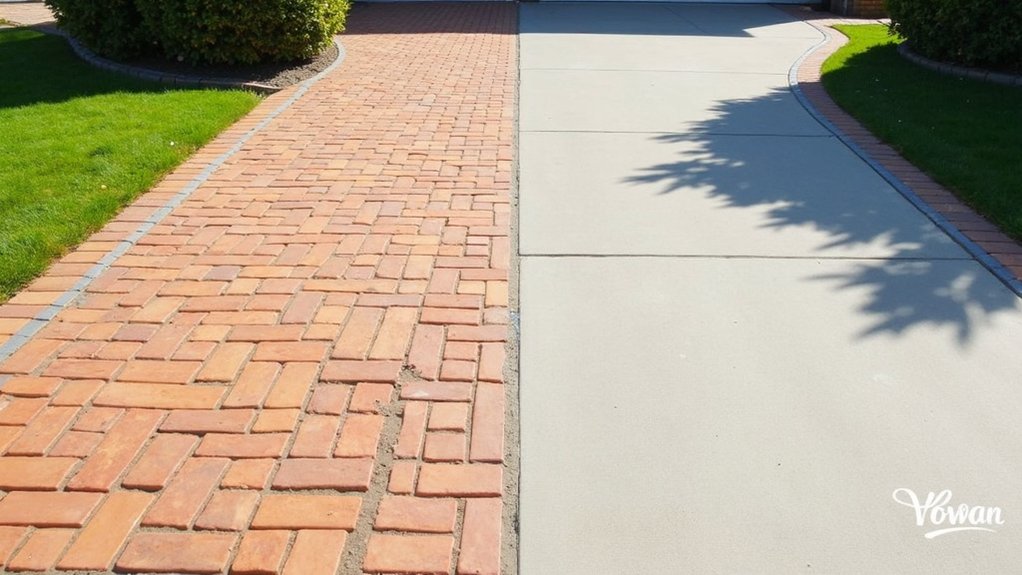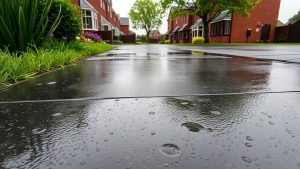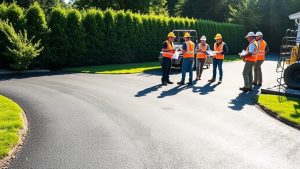To keep your concrete driveway cool in summer, consider using chilled water and ice in the mix to help lower temperatures. Choose light-coloured or reflective coatings that minimise heat absorption. It’s best to schedule pouring during cooler times, such as early morning or late afternoon. Installing sunshades and windbreaks can provide essential protection from direct sunlight. Pre-cooling aggregates and using evaporation retarders can help maintain moisture levels. Additionally, look into innovative cool pavement technologies for longer-lasting results. Keep reading for more effective cooling strategies.
Table of Contents
ToggleKey Takeaways
- Opt for light-coloured or reflective coatings to reduce surface temperatures by 25-30% and improve energy efficiency.
- Schedule concrete pouring during cooler periods, like early morning or late afternoon, to avoid rapid drying.
- Use continuous moist curing methods to ensure maximum strength and prevent cracking in hot weather.
- Consider cool pavement technologies, such as porous pavements and reflective coatings, to lower surface temperatures.
- Set up temporary sunshades or windbreaks to shield from UV rays and minimise thermal expansion on hot summer days.
Utilize Chilled Water and Ice in the Mix
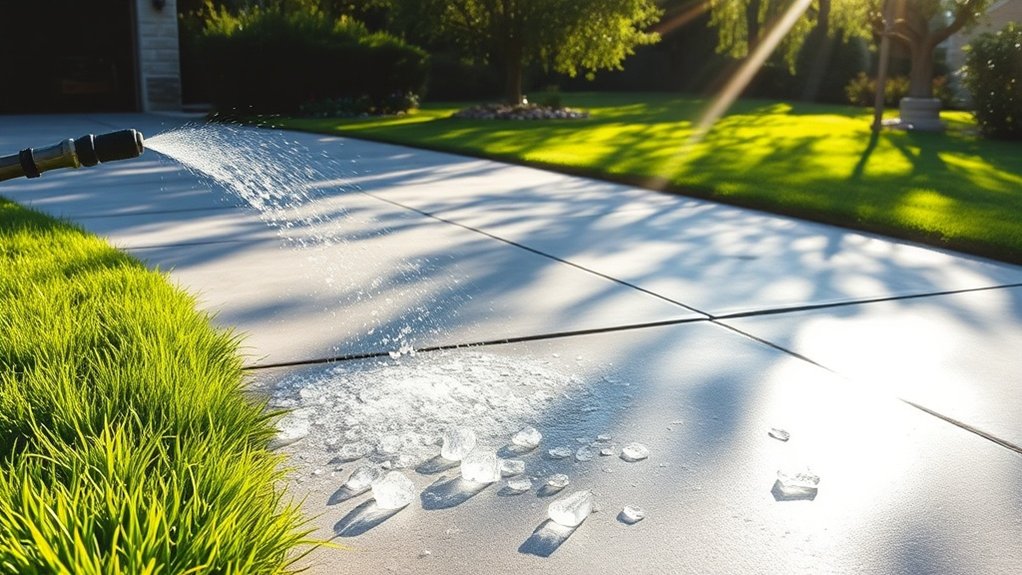
To keep your concrete driveway cool during the summer months, using chilled water and ice in the mix can be very effective. For every 1°F drop in the desired concrete temperature, replace about 2% of the total mix water with ice. For instance, if your mix water is at 27°C (80°F), substituting around 40% with ice can lower the temperature to approximately 16°C (60°F). Chilled water is also important; aim for a temperature of about 11°C (52°F) for optimal results. Flake ice is preferred as it disperses evenly and cools quickly. Implementing concrete cooling strategies ensures that the mixture remains at an optimal temperature, enhancing the overall strength and durability of your driveway.
Choose Light-Colored or Reflective Coatings
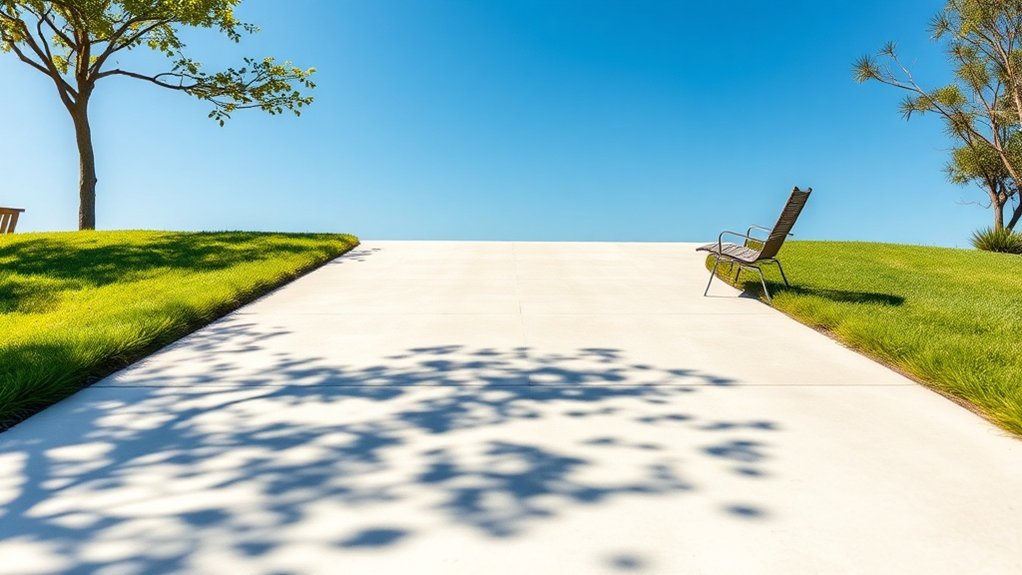
Choosing light-coloured or reflective coatings for your concrete driveway is a practical way to manage heat. These coatings can lower surface temperatures by 25-30% by reflecting infrared rays. Additionally, using a premium acrylic concrete paint sealer can enhance the durability and protection of your driveway against the elements, contributing to its durable protection. When picking colours, consider lighter shades like white, silver, or beige to enhance the Solar Reflective Index and reduce heat absorption. These coatings also provide durability against water, UV light, and stains, keeping your driveway protected and cool. With UV-stable pigments, you can expect long-lasting reflectivity and colour retention. Investing in reflective coatings not only boosts energy efficiency but also supports sustainability, making your driveway a cooler, environmentally-friendly choice.
Schedule Pouring During Cooler Times
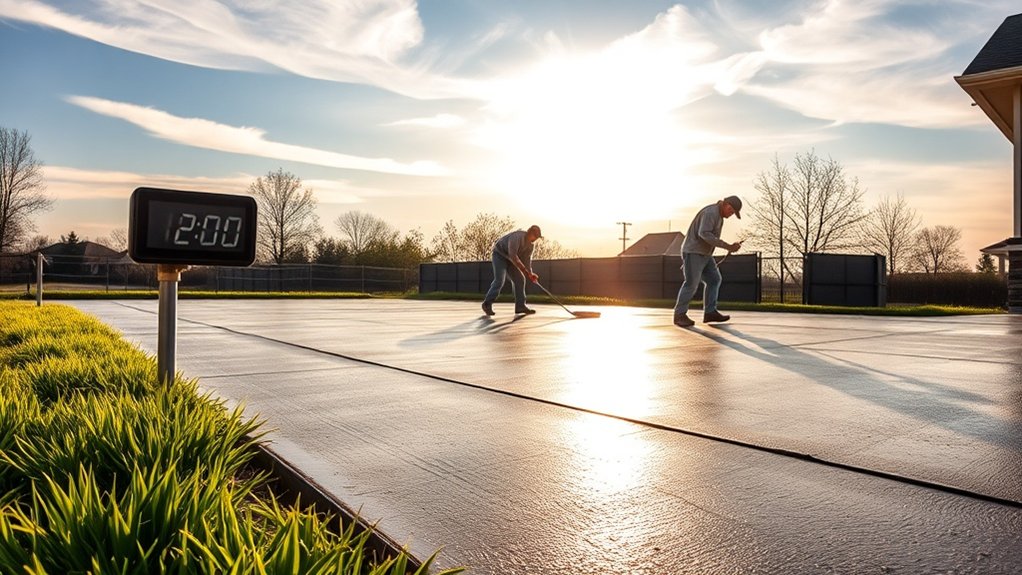
To ensure your concrete driveway cures correctly and maintains its strength, it’s crucial to schedule the pour during cooler times. Aim for temperatures between 10°C and 21°C, preferably in the early morning or late afternoon. This approach helps prevent rapid drying and keeps moisture levels necessary for proper curing. Additionally, pouring in the optimum season is vital for achieving the best results in concrete strength and durability.
| Pour Timing | Recommended Temperature (°C) |
|---|---|
| Early Morning | 10-21 |
| Late Afternoon | 10-21 |
| Avoid Midday | Above 21 |
| Nighttime Monitoring | Below 4 (risk of freezing) |
| Best Seasonal Times | Spring & Autumn |
Keep an eye on the temperature to choose days with mild conditions, protecting your driveway’s durability and performance throughout the summer months.
Implement Temporary Sunshades and Windbreaks
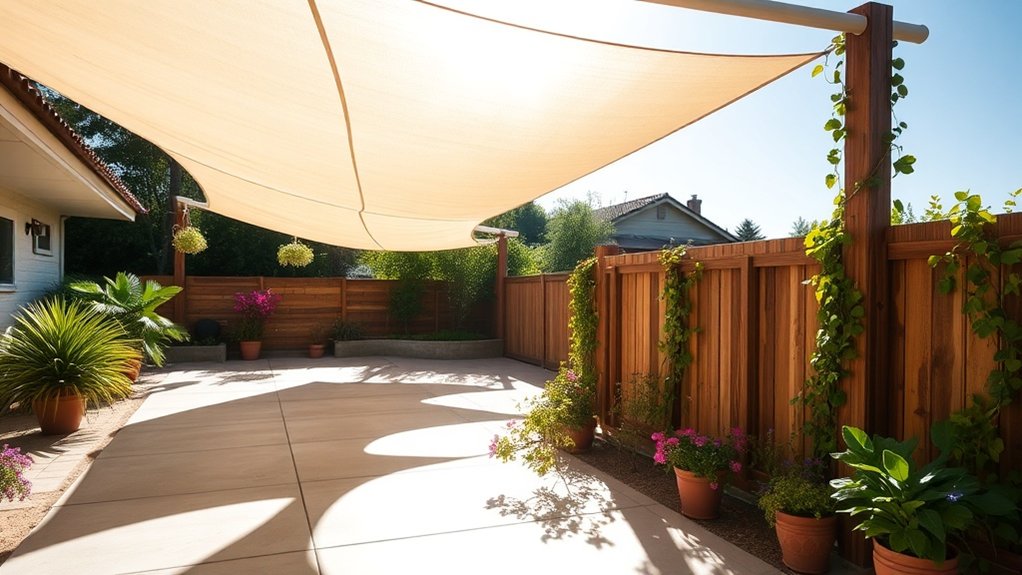
To cool your concrete driveway effectively, it’s important to use temporary sunshades and windbreaks.
By positioning UV-resistant shade sails and natural barriers strategically, you can significantly reduce surface temperatures and prevent heat accumulation.
Consider using materials like canvas for shade sails and hedges or fencing for windbreaks.
This approach not only enhances comfort but also improves the overall usability of your outdoor space.
Benefits of Sunshades
During summer, concrete driveways can become uncomfortably hot and even dangerous. Temporary sunshades and windbreaks provide a straightforward solution to keep these surfaces cool.
Using UV-protective fabrics, sunshades can block up to 99% of harmful rays, reducing temperatures by as much as 20°F (7°C). This creates a more comfortable environment for walking barefoot and protects pets from burns.
Proper installation ensures that these shades effectively shield your driveway from direct sunlight, which helps prevent thermal expansion and extends its lifespan.
Additionally, by reducing the heat radiating back into the environment, sunshades can help lower energy consumption and improve air quality, making them a sensible choice for any outdoor space.
Types of Windbreaks
Windbreaks are vital for keeping your concrete driveway cool during the hot summer months. You can opt for natural windbreaks or structural screens to effectively shield against heat and airflow.
| Type | Description | Benefits |
|---|---|---|
| Natural Windbreaks | Tall trees and dense shrubs | Reduces sun exposure, improves air quality |
| Structural Screens | Fences or louvered panels | Shields from wind, controls airflow |
| Temporary Canopies | Pop-up structures for quick setup | Mobile shade, enhances airflow |
Natural windbreaks, like tall trees, are excellent for reducing direct sunlight and enhancing air quality around your home. On the other hand, structural screens, such as fences, provide a solid barrier against gusts of wind while allowing for some airflow control. If you need something more flexible, temporary canopies are easily set up to provide instant shade and improve ventilation.
Placement Strategies for Effectiveness
Implementing effective placement strategies for temporary sunshades and windbreaks can significantly enhance the cooling effect on your concrete driveway during the summer months.
Here are some straightforward tips to optimise shade placement and airflow:
- Align your sunshades to block the sun’s peak rays by observing its path, particularly during midday and afternoon.
- Use removable poles for your temporary shades, allowing for easy repositioning as the sun moves throughout the day.
- Install windbreaks downwind of your driveway to reduce hot breezes, complementing the shade and improving airflow.
Pre-Cool Aggregates Before Mixing
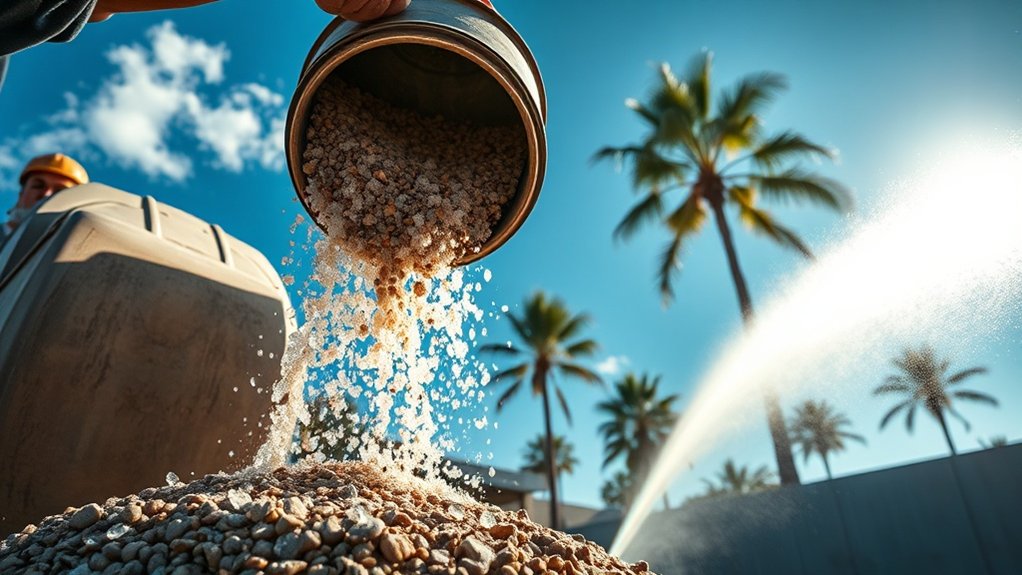
To keep your concrete driveway cool during summer, pre-cool your aggregates before mixing.
Store them in shaded areas or use water spraying methods to effectively reduce their temperature.
This minimises heat retention in your mix, enhancing the durability and comfort of your driveway while supporting sustainable building practices.
Aggregate Storage Techniques
Effective aggregate storage techniques are crucial for keeping temperatures low before mixing, and employing various cooling methods can significantly enhance concrete performance.
Here are three straightforward strategies to improve cooling efficiency and manage aggregate temperature:
- Shaded Storage: Store aggregates in shaded areas or temperature-controlled environments to prevent them from absorbing heat from the sun.
- Air Cooling: Pass chilled, ventilated air through moist aggregates in silos to encourage evaporative cooling.
- Insulated Containers: Use insulation jackets or cooled storage units to keep temperatures low before batching.
These methods can help ensure that your concrete remains at optimal performance levels.
Water Spraying Methods
Effective aggregate storage techniques are essential for successful concrete mixing, but without pre-cooling methods, you may still face high temperatures during the mixing process. Water spraying is a practical way to cool aggregates before mixing, significantly lowering their temperature. Here’s a quick overview:
| Method | Benefits |
|---|---|
| Ice Spraying | Absorbs heat, lowers mix temperature |
| Chilled Water Spraying | Reduces temperature by up to 5°C |
| Flooded Silos | Provides continuous cooling, allows for efficient reuse |
Implementing these methods can help ensure a better quality concrete mix.
Maintain Continuous Moist Curing
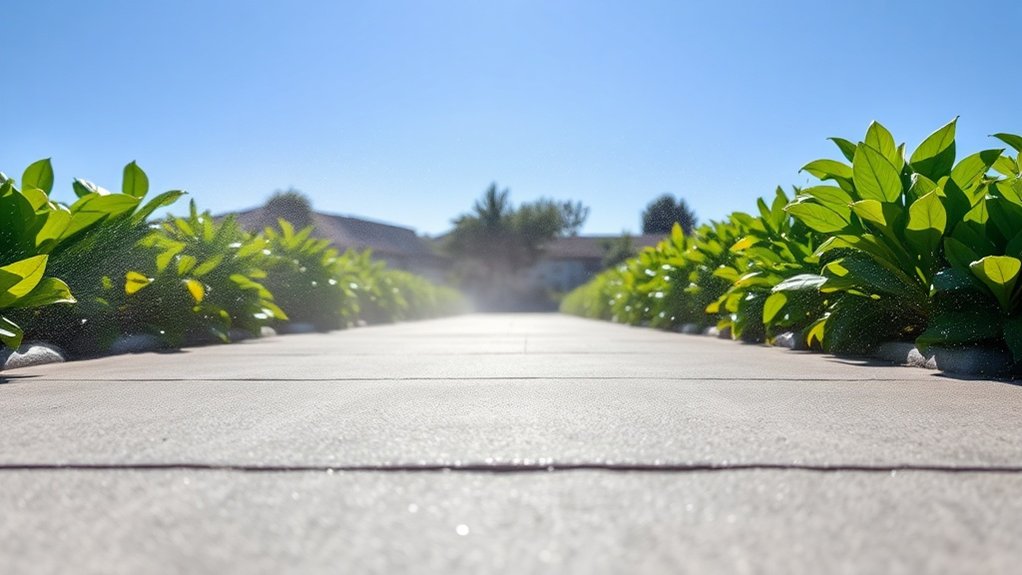
Maintaining continuous moist curing is vital for ensuring your concrete driveway achieves maximum strength and durability.
By optimising moisture retention, you can prevent cracking and enhance resistance to environmental challenges.
Here are three effective curing techniques:
- Flooding: Keep the surface submerged in water for at least seven days to encourage proper hydration.
- Saturated Covers: Use wet burlap or blankets to retain moisture while cooling the surface through evaporation.
- Ponding: Create shallow pools on the concrete to ensure a constant supply of moisture.
These methods not only strengthen your driveway but also improve its longevity against wear and environmental stressors.
Prioritise continuous moist curing for a robust, durable surface that lasts.
Apply Evaporation Retarders
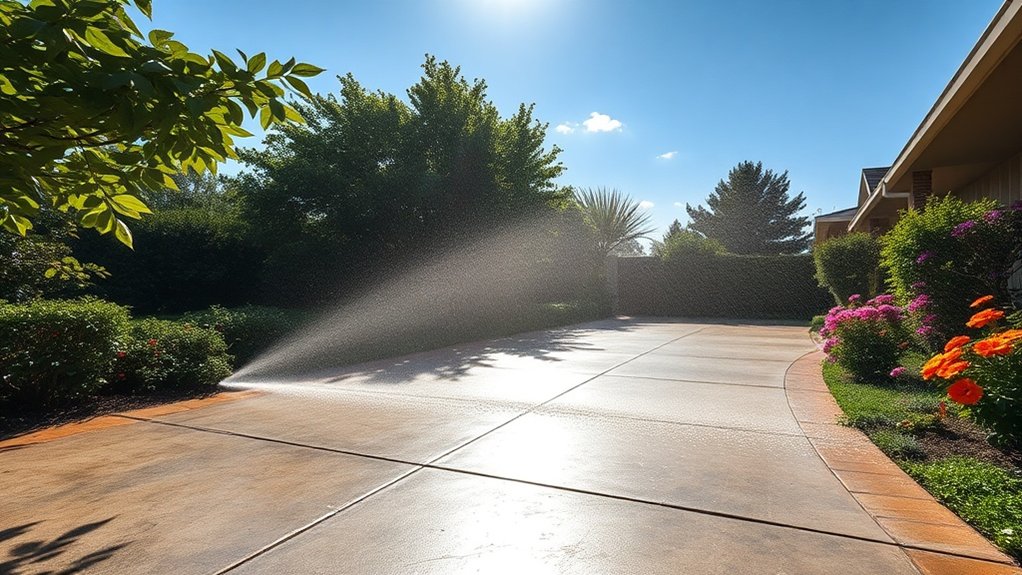
After ensuring continuous moist curing, consider applying evaporation retarders to protect your concrete driveway further.
These products are crucial in hot, dry conditions, as they significantly reduce moisture loss during finishing and curing. Apply them immediately after screeding and before finishing for maximum effectiveness and to maintain workability.
Be aware that in severe conditions, you may need to reapply.
Choose water-based emulsions that comply with VOC regulations and contain a fugitive dye for easy visibility.
Ready-to-use versions offer convenience, but ensure you spray evenly to avoid puddling.
While evaporation retarders improve surface quality and hydration, they shouldn’t replace traditional curing methods for optimal durability.
Explore Cool Pavement Technologies
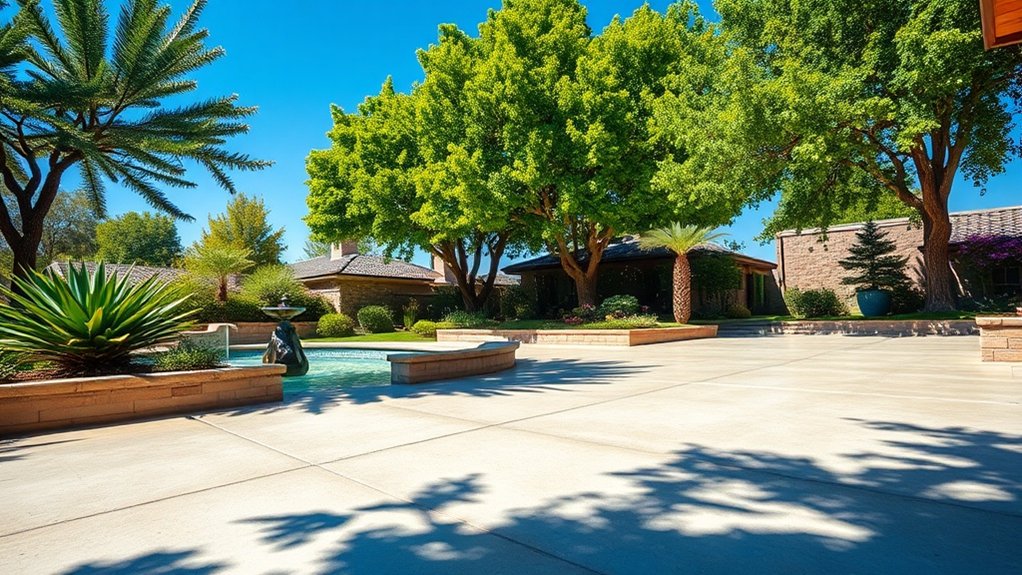
As temperatures rise in summer, exploring cool pavement technologies can significantly improve the comfort of your concrete driveway.
Here are three innovative options worth considering:
1. Reflective Coatings: These coatings enhance solar reflectance, which can dramatically reduce surface temperatures while also increasing the longevity of your driveway.
2. Porous Pavements: This type of pavement allows water to seep through, promoting evaporative cooling and minimising heat retention.
It’s a cooler and more sustainable choice for your driveway.
3. Infrared Emittance: By improving a pavement’s ability to emit infrared radiation, it can release heat more quickly, keeping temperatures lower both during the day and at night.
This helps to combat the urban heat island effect effectively.
Integrate Evaporative Cooling Techniques
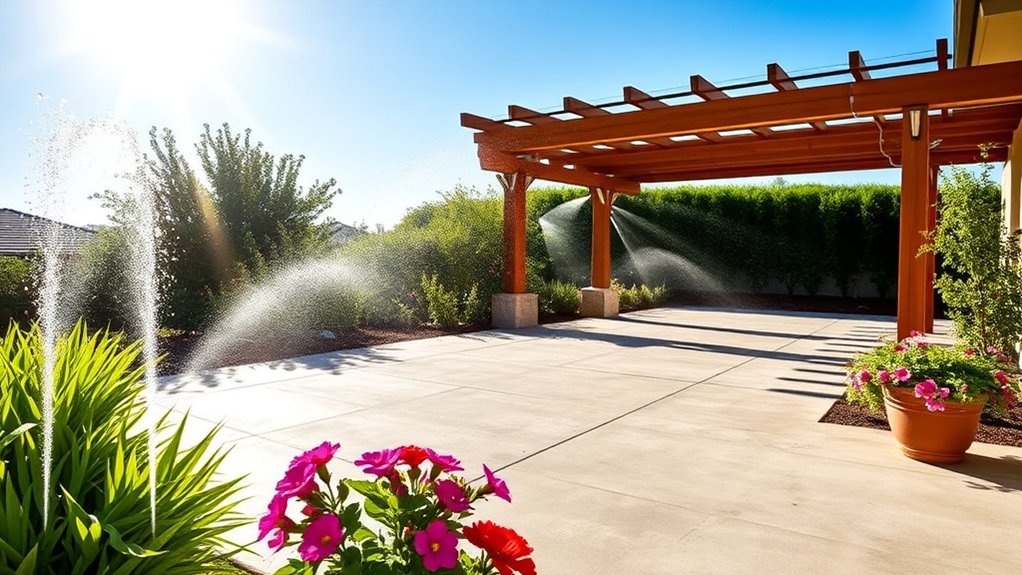
To keep your concrete driveway cool during the hot summer months, it’s essential to incorporate evaporative cooling techniques. Using misting systems can create a refreshing microclimate by dispersing fine water droplets, while moisture-retaining coverings, like wet burlap, help slow moisture loss, reducing the risk of cracking. Additionally, pre-wetting aggregates and the subbase can further decrease heat transfer, helping to cool the concrete.
| Technique | Benefits | Considerations |
|---|---|---|
| Misting Systems | Lowers surface temperature | Requires consistent coverage |
| Moisture Retaining Coverings | Enhances hydration and durability | May need frequent wetting |
| Pre-Wetting Aggregates | Reduces heat absorption during hydration | Can affect slump and workability |
| Environmental Controls | Maximises evaporative potential | Timing and shading are crucial |
Consider Color and Surface Texture Choices
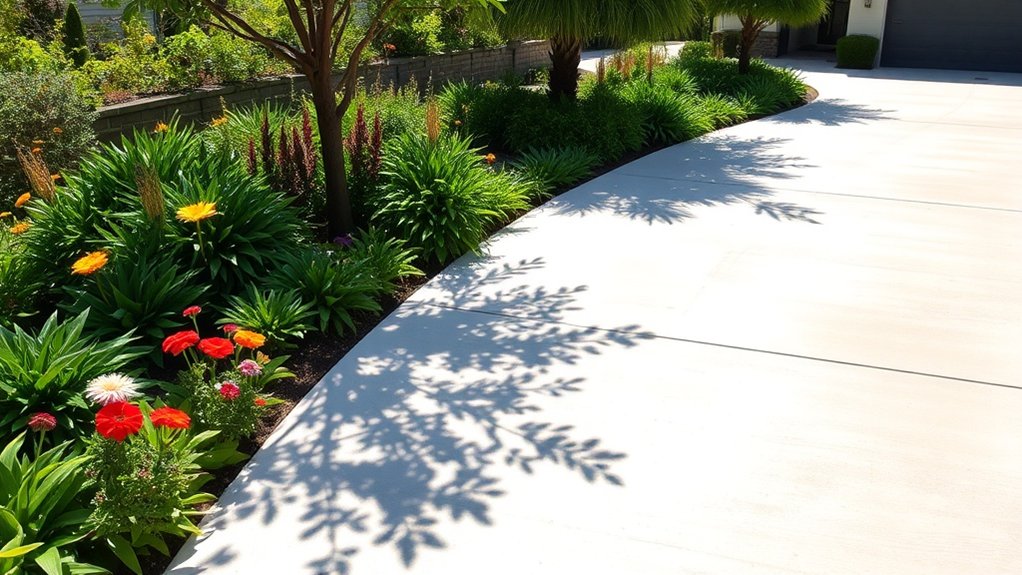
When selecting the colour and surface texture for your concrete driveway, you’re making more than just a style choice; you’re also affecting how it manages temperature during the hot summer months. The right selections can significantly lower heat absorption, making it more comfortable.
- Colour Choice: Lighter shades reflect sunlight, keeping the surface up to 30°F (about 17°C) cooler than darker colours. For example, a light grey or beige driveway will be much more pleasant to walk on than a dark charcoal one.
- Texture Considerations: While the texture has a minor effect on heat retention, smoother finishes can improve solar reflectance, helping to keep the surface cooler.
- Moisture Retention: Textured surfaces can retain dew, which may provide a slight cooling effect.
Frequently Asked Questions
How Does Concrete Color Affect Heat Retention?
Concrete colour significantly influences heat absorption. Lighter shades reflect solar radiation, which helps keep surfaces cooler, while darker shades absorb more heat, increasing surface temperatures. For instance, opting for pale grey or white concrete can make outdoor areas more comfortable during hot months, promoting sustainability and enhancing usability.
What Are the Benefits of Textured Concrete Surfaces?
Textured surfaces improve safety with better slip resistance and effectively reflect heat. They can imitate natural materials, enhancing the look of a space and increasing property value. Additionally, their durability and low maintenance requirements make them a practical choice for various settings. For example, textured concrete patios not only look great but also provide a safer surface for families and guests.
Can Landscaping Around the Driveway Help With Cooling?
Yes, smart landscaping around your driveway can help keep it cooler. By planting trees and shrubs in strategic spots, you can create shade and reduce heat absorption. This not only makes your driveway more comfortable during hot summer days but also enhances the overall look of your outdoor space. For example, a well-placed tree can provide shade for your car and reduce the amount of heat that radiates from the driveway surface.
How Often Should I Apply Reflective Coatings?
Applying reflective coatings every 2 to 5 years is essential for keeping your driveway protected. Consider factors like weather conditions and the level of traffic it endures to determine the right frequency for your application. This will help ensure your concrete surface remains durable and sustainable.
Are There Specific Plants That Reduce Heat Around Concrete?
Yes, shade plants like maples and oaks effectively cool areas around concrete, while heat-absorbing plants such as creeping thyme help lower temperatures. Combining these plants can enhance cooling and create a more pleasant outdoor space.
Conclusion
By using effective strategies, you can significantly decrease the heat absorption of your concrete driveway, keeping it cool during the hot summer months. A cooler driveway not only improves your outdoor experience but also protects your investment. Consider options like reflective coatings or planting shade trees, which can help lower temperatures. These solutions create a more comfortable space while being environmentally friendly. Embrace these methods to ensure your driveway withstands the heat.
Just how do stamped and plain concrete driveways compare in durability, cost, and aesthetics? Discover which option truly suits your Read more
Learn about the lifespan and durability of concrete driveways, and discover essential tips to ensure yours lasts for decades to Read more
On a budget? Discover how block paving and concrete driveways compare in costs and long-term value—your wallet might thank you!

